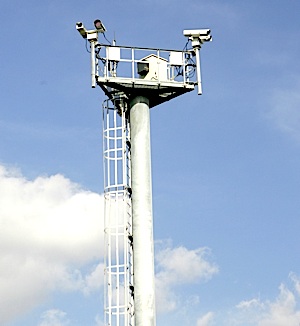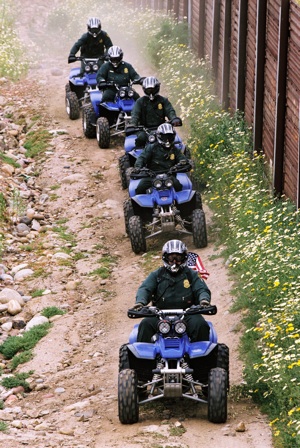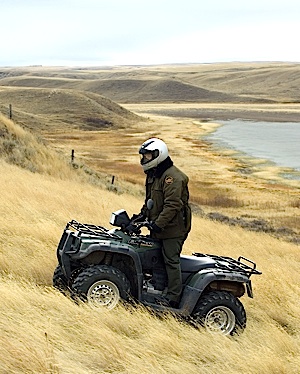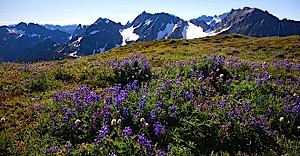A summer hike up the south ridge of Cadillac Mountain in Acadia National Park takes you through cool forests of conifer and up onto the mountain's granite shoulders with great views of Frenchman Bay.
There are great expanses of granite once you start to clear the forest where you can set a while and have a picnic, and, of course, enjoy stunning views. And, thanks to environmental laws such as the National Environmental Policy Act and the National Park Service Organic Act, there's no 125-foot-tall tower festooned with dishes and antennae to greet you.
"In the past there has been a proposal by both the Coast Guard and, separately, by Homeland Security, for antennas on Cadillac, and we were able to successfully argue against that," says Acadia Superintendent Sheridan Steele. "My point being that had they not had to adhere to NEPA and other similar requirements they would have probably just announced that there was going to be an antenna on top of Cadillac."

Could a tower similar to this one sprout atop Cadillac Mountain in Acadia National Park if H.R. 1505 passes Congress? Border Patrol photo by James Tourtellotte .
Acadia is not alone among the parks that could be impacted if U.S. Reps. Doc Hastings and Rob Bishop succeed in pushing H.R. 1505, a measure that would "prohibit the Secretaries of the Interior and Agriculture from taking action on public lands which impede border security on such lands."
Without having to adhere to NEPA, or the Wilderness Act, or the Endangered Species Act, or any number of other measures ranging from the Federal Water Pollution Control Act and the Clean Air Act to the Archaeological Resources Protection Act and the Coastal Zone Management Act, the Border Patrol in theory would not have to answer to the National Park Service before erecting towers, building fences, or cutting new roads for access into units of the National Park System that lie within a 100-mile-wide corridor along the country's borders -- the southern border with Mexico, the northern border with Canada, or the West or East coasts.
Parks that fall within that 100-mile swath include Big Bend, Isle Royale, Everglades, Biscayne, Dry Tortugas, Glacier, North Cascades, Voyageurs, Virgin Islands, Olympic, Redwoods, Channel Islands, and all the national seashores.
“I don’t like, in these sort of situations where you have this general language that the Homeland Security Department does not have to comply with laws, it’s hard to infer what the results of not complying with the law is going to be. Other than things that we’ve already seen in places like Organ Pipe Cactus, where we see vehicular use in wilderness areas and things like that that are problematic in terms of harming natural resources," says Kristen Brengel, director of legislative and government relations for the National Parks Conservation Association.
"When you’re throwing 30 laws out the window in order to accommodate any type of Homeland Security activity, the extent of which we have no idea, and the agencies themselves are saying this is completely unnecessary, it’s difficult to really understand what Congress intends to direct the agencies to do in these places that requires them to be exempt from law," she adds.

Border Patrol agents patrol the Southwestern border on ATVs. Border Patrol photo by James Tourtellotte.
Rep. Bishop, a Utah Republican, long has been pushing this issue, and has in the past asked the Government Accountability Office to determine whether the various environmental and Park Service regulations impede the Border Patrol from securing the country's borders from terrorists, drug runners, and illegal immigrants.
Studies have not entirely supported the congressman's cause. In 2010, after a nearly year-long review, the U.S. Government Accountability Office determined that while environmental regulations at times slowed Border Patrol operations in the Southwest, a strong majority of agents-in-charge "reported that the overall security status of their jurisdiction is not affected by land management laws."
A far greater problem, the agents-in-charge told the GAO investigators, is the lay of the land in the Southwest. And while "four patrol agents-in-charge reported that delays and restrictions negatively affected their ability to achieve or maintain operational control, they have either not requested resources to facilitate increased or timelier access or have had their requests denied by senior Border Patrol officials, who said that other needs were greater priorities for the station or sector."
A separate report released that year, Interagency Cooperation on U.S.-Mexico Border Wilderness Issues, written by Kirk Emerson, PhD, concluded that the Border Patrol was managing to work with land-management agencies under the existing regulatory framework to accomplish their tasks.
"After a slow start and much trial-and-error, cooperation among federal departments and agencies charged with protection of the border and wilderness areas has been improving in the past few years," added Ms. Emerson, a consultant based in Tucson, Arizona.
"Departmental leadership has issued several policy directives and put in place organizational mechanisms that have created a framework for collaboration and conflict resolution among the departments and their respective agencies on the ground."
Checks with superintendents at Glacier and North Cascades national parks, two parks that hug the U.S.-Canadian border, found there's a great deal of ongoing cooperation between their staffs and the Border Patrol.
“My staff and I, we actually have a pretty good working relationship with the Border Patrol here," says North Cascades Superintendent Chip Jenkins. "They are a constant presence in the park. They have a boat on Ross Lake, they are routinely patrolling through the campgrounds, they are routinely on the trails here. They’re on the highway.
“Our rangers meet with the Border Patrol as well as other agencies on a monthly basis to discuss and coordinate activities," Superintendent Jenkins went on. "We coordinate and cooperate when things are going on in the field and radio frequencies and what not. From my understanding from talking with the (Border Patrol) commander of the Blaine (Washington) sector, things are working. There’s not anything broken, at least we’ve not heard from the Border Patrol that they consider that things are not working.”

Already Border Patrol agents are using ATVs to patrol in Montana, such as this agent near Sweetgrass, Montana. Border Patrol photo by Gerald Nino.
At Glacier National Park, where a 20-foot wide grassy and rocky band marks the U.S.-Canadian border, Superintendent Chas Cartwright echoed Superintendent Jenkins on describing his working relationship with the Border Patrol and Homeland Security and added that he'd hate to think what might happen if H.R. 1505 became law.
"The reason why I’m so much into keeping things, taking advantage of the existing relationship, is that everything we do in federal land management is about relationships, and keeping it local on a day to day basis," said Superintendent Cartwright. "If we keep that mutual respect for each others' missions, I think that we’re going to get both jobs done and that Glacier National Park is not going to be impacted.
"That job of preserving and protecting Glacier as an incredibly special place, it has almost every designation that you can think of, from national park to World Heritage Site, international peace park, biosphere reserve," he continued. "We have to treat it with the respect that it deserves, and that’s the job. We can't shirk our responsibilities, we’ve got to do both. We’ve got to meet security requirements and we’ve got to preserve and protect Glacier National Park.”
At the Department of Interior, which oversees the Park Service, officials declined to comment on the legislation as it's still working its way through the Congress. However, they pointed to testimony the Obama administration presented during a congressional hearing last July. In that hearing Kim Thorsen, Interior's deputy assistant secretary for law enforcement, security, and emergency management, told Rep. Bishop achieving border security and protecting the environment are not mutually exclusive.
She also pointed out a 2009 memorandum of understanding signed between officials from the Interior and Homeland Security departments that addresses Border Patrol access to public lands.
At that signing, Customs and Border Patrol Commissioner W. Ralph Basham said, “No partnership has been more important in our efforts to be good stewards of the environment than our work with the land managers and wildlife experts of the Department of the Interior. Today’s signing of this memorandum of agreement demonstrates that our commitment is not only words, but actual resources which have been set aside to allow DOI to mitigate the impact of our border security efforts in environmentally sensitive areas.”
In her testimony, Ms. Thorsen pointed out how H.R. 1505 could impact public lands from coast-to-coast and border-to-border. "As drafted, this bill could impact approximately 54 units of the National Park System, 228 national wildlife refuges, 122 units of the National Wilderness Preservation System managed by Interior, and 87 units of BLM's National Landscape Conservation System, resulting in unintended damage to sensitive natural and cultural resources, including endangered species and wilderness," the deputy assistant secretary testified.
"The bill could also affect up to 1,000 miles of Bureau of Reclamation project purpose infrastructure (including river channel, levees, canals and bridges) required to meet Colorado River water delivery obligations to U.S. and Mexico water users. H.R. 1505 would likely have a significant impact on Interior’s ability to carry out our overall mission related to protection of natural and cultural resources on our federally managed and trust lands."

North Cascades Nationa Park officials say they have a good relationship with the Border Patrol when it comes to patrolling the park. View from Sahale Arm Trail by Ranger David, NPS.
Despite testimony at an April 2011 hearing from Interior and Border Patrol officials that environmental laws were not impeding efforts, and that success was being met in stemming both the flow of illegals and the environmental degradation they've caused, Mr. Bishop exited the hearing with a different conclusion.
"It is exceptionally clear after hearing today’s testimony that significant limitations continue to be placed on the U.S. Border Patrol’s access to some of the most highly trafficked areas along the border," the congressman said. "Environmental policies cannot take precedent over the safety and security of all Americans and that is exactly what is occurring today.
"In order for the Border Patrol to be as effective as possible in deterring and apprehending criminals they need to have routine access to our federal lands. The reality is that many parts of the U.S. along the southern border region are too dangerous for Americans to enter because they are overrun with drug traffickers and human smugglers. This is unacceptable and I plan to ensure that law enforcement is no longer hindered from doing their jobs to keep Americans safe.”
Back at North Cascades, Superintendent Jenkins acknowledged that "there are ... people that illegally cross the border or attempt to smuggle drugs across the border. But it’s pretty infrequent."
"What’s interesting about it," he went on, "is there’s a strong track record of the park rangers finding and apprehending the people. (North Cascades is) extremely remote, it’s extremely difficult terrain, the weather is extremely harsh, so conducting travel across the border, it’s a difficult thing.
"I also think, more broadly speaking, related to the legislation that Mr. Bishop has put forward, from our perspective is with all of the resources that Department of Homeland Security are providing, the staffing, the helicopters and the boats and the electronic surveillance equipment and funding and whatnot, with all of the ingenuity and creativity that this country has, it seems to us that we ought to be able to figure out how to have a secure border and protect our environment at the same time. It doesn’t seem like we should have to trade off those.”
From Ms. Brengel's viewpoint, Reps. Bishop and Hastings are trying to solve a problem that doesn't exist.
"If the agencies themselves are saying that they can work with each other to accommodate their security activities while still keeping in mind the natural resources, then there’s really no problem that this legislation is addressing," she said. "I’ve been referring to the legislation on the Hill as a solution in search of a problem. I think that the committee is trying to make a political point here and compromising our national parks in the process and it’s completely unnecessary.
“They want to make a statement about border and security, but they don’t have any evidence to show that these laws are complicating it," she said.
Editor's note: See the accompanying story on efforts at Organ Pipe Cactus National Monument to restore impacts illegal traffic has done to wilderness in the park.


 Support Essential Coverage of Essential Places
Support Essential Coverage of Essential Places







Comments
The attacks on ORPI's wilderness by Cong. Rob Bishop are just one
small part of his declared war on federal land ownership -- and
especially wilderness -- in the west. Bishop won't be satisfied until
all federal land either has an oil well on it or has been privatized and
handed off to ownership by powerful development interests. (I know
that's a bit of an exaggeration, but it's not a big one.)
By cloaking his hatred for wilderness and parks in the paranoia of
Homeland Security, he sees what he hopes will be a way to succeed in
this by arousing the wrath of gullible ultra-conservatives against what
he frequently calls Federal Land Grabs.
The truth, according to several rangers, Border patrolmen, and a
member of Arizona's Department of Public Safety with whom I spoke early
last year, is that it's actually easier
to apprehend illegals within wilderness areas than on private lands.
That's because when electronic monitors pick up movement, they can be
reasonably sure it's illegal. It's not necessary to try to sort out the
illegal from legal activities such as a rancher herding cattle or
plowing a field. Once movement has been detected, it's a fairly easy
job to simply monitor it until the subjects reach a road where they can
be nabbed without entering the wilderness with machinery. They told me
there is a much higher success rate because of wilderness.
I've said before that Congressman Bishop is the flip side to the same coin that has unreasonable environmental idol worshipers as his counter. You live in that world and Bishops are what you get. Having a little (a lot is needed) concern for the whole country including the parks as a whole would seem to be what's needed. It's not inconceivable that the likes of a OWS like movement could set their sites on the Parks and the increasing elitest attitudes looking at the public as the enemy of the resource. The big picture and not dividing the country further by individual interest groups. I know that runs counter to what is being promoted by many selfish and very hurtful officials but ...
I guess everyone has forgot about the wildlife cams in mountain parks bordering the Mexico border that showed long lines of illegal aliens following trails through the parks until they reached one of the roads that criss cross the area to meet up with their ride into town. I consider the Canadian border area one of the prettiest places there is in contrast to the dry hot desert of the US/Mexican border.
The illegal aliens leave tons of trash in their wake in all desert areas they cross including the parks. The border patrol needs to be allowed to go after the illegals in areas like this and close up the trails of which there are hundreds and start deporting these people instead of ignoring it. Because of the drug cartels most of the parks are not safe to camp in anymore unlike the northern border.
During the past three years I've enjoyed volunteering at some of America's most beautiful and valuable resources. None is any more valuable nor beautiful than Organ Pipe Cactus National Monument. I spent six months at ORPI last winter (2010-11), and found the cooperation of the Border Patrol, park law enforcement, local police and state police satisfactory. While I was sometimes very disappointed in how the Border Patrol paraded through the resource and abused it, I realized they had a job to do. I also felt the park leadership attempted to cooperate within reason. ORPI is much too beautiful to be closed, as apparently Rep. Bishop would like. If the likes of Bishop and others succeed, Americans could lose access to some of our most valuable resources in the name of law enforcement. Somehow I think the Patriot's Act and other responses to 9/11 sometimes step a bit too far on the conservative side. Protect our borders, yes, but don't keep us from getting to see them.
Conservative? Could it be Liberal that we have this problem to begin with?
Excellent article thank you! I dont believe there is any justification for this bizarre bill pushed by arizona tea party. HR 1505 would allow Dept of Homeland security to build roads, bases, drive damaging off road vehicles and place military sensors ANYWHERE in Glacier National Park --every acre of which is within the arbitrary 100 miles of the quiet Canadian border. The Border Patrol rides backcountry trails near Canadian border in Montana by horseback by the way. A quieter more effective patrol method than noisy ATVs which would severly damage most narrow mountain trails in Glacier. Have you seen any specific analysis or reports on the Canadian border?
The question that I will ask everyone is this. Is it completely safe for any US citizen to go to any park or federal land on our borders? If it is not, then someone is remiss for not insuring the safety of the visitors who wish to use these lands for our enjoyment. If the Border Patrol is not permitted to insure our safety, then the Park Service should take on that responsibility. I would only venture to guess on who is the most qualified. I know for a FACT that areas on the border are not condusive to use by we park visitors. It is easy to sit in the sweet, smug areas of Middle America and say what the border area should do. It would not be nearly as easy for these same people to look at reality and make our border parks safe. While we should control our borders, I would again venture to say that our northern national park borders do not have the same issues with violance as our southern borders. Again, look at facts. I no doubt agree that it is much easier to work together in areas such as Glacier to achieve safety than Organ Pipe Cactus NM, Cabeza Prieta WMR or Buenos Aires NWR. There is a median point that will do both protect and conserve. Find it!
In response to Barbara G.: Perhaps you should visit some of those beautiful desert parks during the cool of winter. You might come to a greater appreciation of the desert, especially the "green" Sonoran Desert. It is really a beautiful place. During our 6 months at ORPI, we witnessed occasional encounters of illegals seeking water or food, but law enforcement responded quickly to overtake those people and remove them from the park. The presence of law enforcement at ORPI (including 20 sworn officers on staff) is so great, they almost trip over each other. As for safety, much of the park is closed. Alas, this is the beautiful wilderness. The area open to the public is only about 5 percent of the area of the park and it is so well patrolled, there is far more crime in any city in the country than at ORPI.